NCERT Solutions for Class 10 Science Chapter 10 Light Reflection and Refraction
- Reflection of Light:
- Introduction to reflection and the laws of reflection.
- Illustration of the formation of an image in a plane mirror.
- Understanding the virtual and erect nature of the image formed in a plane mirror.
- Spherical Mirrors:
- Introduction to spherical mirrors, concave and convex mirrors.
- Ray diagrams for different object positions in front of a concave or convex mirror.
- Characteristics of the images formed by spherical mirrors (real, virtual, magnified, diminished, etc.).

- Mirror Formula and Magnification:
- Derivation and understanding of the mirror formula.
- Calculating the magnification of an image formed by a spherical mirror.
- Refraction of Light:
- Introduction to refraction and the laws of refraction.
- Explanation of why a coin appears to be raised when placed in a glass of water.
- Refraction through a Lens:
- Introduction to lenses, converging and diverging lenses.
- Ray diagrams for different object positions in front of a converging or diverging lens.
- Characteristics of the images formed by lenses.
- Power of a Lens:
- Understanding the power of a lens and its unit, the dioptre.
- Calculating the power of a lens.
- Refraction by Spherical Lenses:
- Ray diagrams and characteristics of images formed by spherical lenses.
- Image Formation in Lenses:
- Determining the nature, position, and size of images formed by lenses.
- Vision Correction:
- Explanation of vision defects (myopia and hypermetropia) and their correction using appropriate lenses.
- Dispersion of White Light:
- Explanation of dispersion and the formation of a spectrum of colors by a glass prism.
- Atmospheric Refraction:
- Understanding the bending of light due to atmospheric conditions and its effects.
NCERT Solutions for this chapter will provide answers to questions and problems related to these topics, helping students understand the concepts and solve problems effectively. You can refer to your NCERT textbook or study materials for the specific solutions to exercises and questions in this chapter.
Page Number: 168
Question 1
Define the principal focus of a concave mirror.
Answer-
A concave mirror’s principal focus is the point on its principal axis where, following reflection from the concave mirror, all parallel light rays that are near to the axis converge.
Question 2
The radius of curvature of a spherical mirror is 20 cm. What is its focal length?
Answer-
Focal length = 12 x Radius of curvature = 12 x 20 cm = 10 cm
Question 3
Name a mirror that can give an erect and enlarged image of an object.
Answer-
Concave mirror.
Question 4
Why do we prefer a convex mirror as a rear-view mirror in vehicles ?
Answer-
There are two reasons why we like convex mirrors over rectangular ones for our rearview mirrors in cars:
- The items are always shown in an upright position using a convex mirror.
- Convex mirrors provide a broad field of view of the traffic behind them since the image they generate is greatly decreased or considerably smaller than the item. A driver can see a wider portion of the traffic behind them thanks to a convex mirror.
Page Number: 171
Question 1
Find the focal length of a convex mirror whose radius of curvature is 32 cm.
Solution-
R = +32 cm and f=R2=+322=+16cm
Question 2
A concave mirror produces three times magnified (enlarged) real image of an object placed at 10 cm in front of it. Where is the image located ?
Solution-
Because the image is real, so magnification m must be negative.
Thus the image is located at a distance of 30 cm from the mirror on the object side of the mirror.
Page Number: 176
Question 1
A ray of light travelling in air enters obliquely into water. Does the light ray bend towards the normal or away from the normal ? Why ?
Answer-
The light-ray bends towards the normal because the ray of light goes from a rarer medium to a denser medium.
Question 2
Light enters from air to glass having refractive index 1.50. What is the speed of light in the glass ? The speed of light in vacuum is 3 x 108 ms-1.
Solution-
Refractive index of glass, n8 = 1.50

Question 3
Find out, from Table 10.3, the medium having highest optical density. Also find the medium with lowest optical density.
Answer-
According to table 10.3, the diamond has the largest optical density because of its highest refractive index (= 2.42).
Air has the lowest optical density because it has the lowest refractive index (1.0003).
According to table 10.3, the diamond has the largest optical density because of its highest refractive index (= 2.42).
Air has the lowest optical density because it has the lowest refractive index (1.0003).
Question 4
You are given kerosene, turpentine and water. In which of these does the light travel fastest ? Use the information given in Table 10.3.
Answer–
For kerosene, n = 1.44
For turpentine, n = 1.47
For water, n = 1.33
Because water has the lowest refractive index, therefore light travels fastest in this optically rarer medium than kerosene and turpentine oil.
Question 5
The refractive index of diamond is 2.42. What is the meaning of this statement?
Answer-
When we remark that a diamond has a 2.42 refractive index, we are referring to the fact that the speed of light in diamond is 2.42 times slower than it is in a vacuum.
Page Number: 184
Question 1
Define 1 dioptre of power of a lens.
Answer–
One dioptre is the power of a lens whose focal length is 1 metre.
Question 2
A convex lens forms a real and inverted image of a needle at a distance of 50 cm from it. Where is the needle placed in front of the convex lens if the image is equal to the size of the object ? Also, find the power of the lens. , Sol. Here, u — +50 cm ..
Solution:
Here ν = +50cm
Because the real image is of the same size as the object,
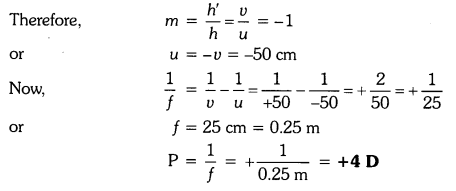
Question 3
Find the power of a concave lens of focal length 2 m.
Solution:
Because the focal length of a concave lens is negative,
therefore f = -2 m
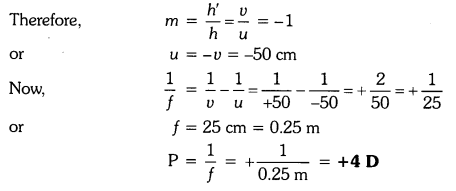
Class 10 Science Chapter 10 Textbook Chapter End Questions
Question 1
Which one of the following materials cannot be used to make a lens ?
(a) Water
(b) Glass
(c) Plastic
(d) Clay
Answer–
(d) Clay
Question 2
The image formed by a concave mirror is observed to be virtual, erect and larger than the object. Where should be the position of the object ?
(a) Between the principal focus and the centre of curvature
(b) At the centre of curvature
(c) Beyond the centre of curvature
(d) Between the pole of the mirror and its principal focus.
Answer-
(d) Between the pole of the mirror and its principal focus.
Question 3
Where should an object be placed in front of a convex lens to get a real image of the size of the object ?
(a) At the principal focus of the lens (b) At twice the focal length
(c) At infinity
(d) Between the optical centre of the lens and its principal focus.
Answer–
(b) At twice the focal length.
Question 4
A spherical mirror and a thin spherical lens have each a focal length of -15 cm. The mirror and the lens are likely to be
(a) Both concave.
(b) Both convex.
(c) the mirror is concave and the lens is convex.
(d) the mirror is convex, but the lens is concave.
Answer-
(a) Both concave
Question 5
No matter how far you stand from mirror, your image appears erect. The mirror is likely to be
(a) plane
(b) concave
(c) convex
(d) either plane or convex.
Answer–
(d) Either plane or convex.
Question 6
Which of the following lenses would you prefer to use while reading small letters found in a dictionary ?
(a) A convex lens of focal length 50 cm.
(b) A concave lens of focal length 50 cm.
(c) A convex lens of focal length 5 cm.
(d) A concave lens of focal length 5 cm.
Answer–
(c) A convex lens of focal length 5 cm.
Question 7
We wish to obtain an erect image of an object, using a concave mirror of focal length 15 cm. What should be the range of distance of the object from the mirror ? What is the nature of the image ? Is the image larger or smaller than the object ? Draw a ray diagram to show the image formation in this case.
Answer-

Question 8
Name the type of mirror used in the following situations.
(a) Headlights of a car.
(b) Side/rear-view mirror of a vehicle.
(c) Solar furnace.
Support your answer with reason.
Answer–
(a) Concave mirrors are used as reflectors in headlights of cars. When a bulb is located at the focus of the concave mirror, the light rays after reflection from the mirror travel over a large distance as a parallel beam of high intensity.
(b) A convex mirror is used as a side/rear-view mirror of a vehicle because
- A convex mirror always forms an erect, virtual and diminished image of an object placed anywhere in front it.
- A convex mirror has a wider field of view than a plane mirror of the same size.
(c) Large concave mirrors are used to concentrate sunlight to produce heat in solar furnaces.
Question 9
One-half of a convex lens is covered with a black paper. Will this lens produce a complete image of the object ? Verify your answer experimentally. Explain your observations.
Answer-
Even having one half of the lens covered in black paper, a convex lens can still create a complete image of the item. It makes sense when you look at the next two examples.
Example 1: When the lens’s upper portion is obscured
In this instance, the lower portion of the lens will refractively affect a light beam originating from the item. As seen in the following figure, these rays intersect at the other side of the lens to create the image of the specified item.
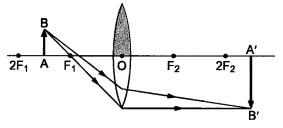
Situation II: When part of the lens is blocked
Here, a light beam originating from the object is bent by the upper part of the lens. As the accompanying diagram shows, the image of the provided item is created when these rays collide at the other side of the lens.
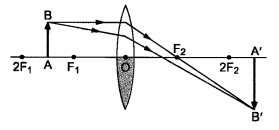
Question 10
An object 5 cm in length is held 25 cm away from a converging lens of focal length 10 cm. Draw the ray diagram and find the position, size and the nature of the image formed.
Answer-
Here : Object distance, u= -25 cm,
Object height, h = 5 cm,
Focal length, f = +10 cm
According to the lens formula, 1f=1ν−1u , we have
⇒ 1ν=1f−1u=110−125=15250orν=25015=16.66cm
The positive value of v shows that the image is formed at the other side of the lens.
The negative value of image height indicates that the image formed is inverted.
The position, size, and nature of image are shown alongside in the ray diagram.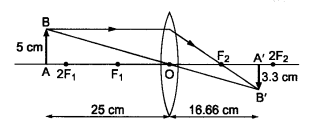
Question 11
A concave lens of focal length 15 cm forms an image 10 cm from the lens. How far is the object placed from the lens ? Draw the ray diagram.
Solution–
Focal length, f = -15 cm, Image distance, ν = -10 cm (as concave lens forms the image on the same side of the lens)
From the lens formula 1f=1ν−1u , we have

Object distance, u = -30 cm
The negative value of u indicates that the object is placed in front of the lens.
Question 12
An object is placed at a distance of 10 cm from a convex mirror of focal length 15 cm. Find the position and nature of the image.
Solution-
Object distance, u = -10 cm, Focal length, f = +15 cm, Image distance, ν = ?
Thus, image distance, ν = + 6 cm
Because ν is +ve, so a virtual image is formed at a distance of 6 cm behind the mirror.
Magnification, m=−υu=−6−30=15 (i.e. < 1)
The positive value of m shows that image erect and its value, which is less than 1, shows that image is smaller than the object. Thus, image is virtual, erect and diminished.
Question 13
The magnification produced by a plane mirror is +1. What does this mean ?
Answer–
Since magnification, m=h‘h=−νu. Given, m = +1, so h’ = h and ν = -u
(i) m = 1 indicates the size of image is same as that of object.
(ii) positive sign of m indicates that an erect image is formed.
The opposite signs of ν and u indicate that image is formed on the other side of the mirror from where the object is placed i.e., image is formed behind the mirror and thus image formed is virtual.
Question 14
An object 5.0 cm in length is placed at a distance of 20 cm in front of a convex mirror of radius of curvature 30 cm. Find the position of the image, its nature and size.
Solution-
Since object size, h = +5 cm,
object distance, u = -20 cm
and radius of curvature, R = +30 cm
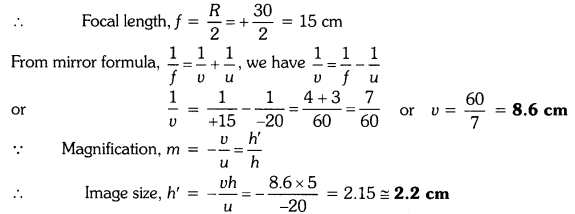
A virtual, erect image of height 2.2 cm is formed behind the mirror at a distance of 8.6 cm from the mirror
Question 15
An object of size 7.0 cm is placed at 27 cm in front of a concave mirror of focal length 18 cm. At what distance from the mirror should a screen be placed, so that a sharp focussed image can be obtained ? Find the size and the nature of the image.
Answer
Here, object size, h = +7.0 cm,
object distance, u = -27 cm
and focal length, f = -18 cm
Image distance, ν = ?
and image size, h’ = ?
From the mirror formula, 1f=1ν−1u, we have

The screen should be placed at a distance of 54 cm on the object side of the mirror to obtain a sharp image.

The image is real, inverted and enlarged in size.
Question 16
Find the focal length of a lens of power -2.0 D. What type of lens is this ?
Answer-
Here, P = -2.0 D
The type of lens is concave because the focal length is negative.

Question 17
A doctor has prescribed a corrective lens of power +1.5 D. Find the focal length of the lens. Is the prescribed lens diverging or converging ?
Answer-
Here, P = +1.5 D

Because the focal length is positive, the prescribed lens is converging.
Page 168
Question 1.
Define the principal focus of a concave mirror?
Answer-
After reflecting from a concave mirror, light beams that are parallel to its principal axis converge at a certain location on the principal axis. The major focus of the concave mirror is located at this position.
Question 2.
The radius of curvature of a spherical mirror is 20 cm. What is its focal length?
Answer-
Radius of curvature, R = 20 cm
Radius of curvature of a spherical mirror = 2 x Focal length (f)
f = R/2 = 20/2 =10cm
Question 3.
Name the mirror that can give an erect and enlarged image of an object.
Answer-
When an object is placed between the pole and the principal focus of a concave mirror, the image formed is virtual, erect, and enlarged.
Question 4.
Why do we prefer a convex mirror as a rear-view mirror in vehicles?
Answer-
Convex mirrors reflect back an erect, imaginary, and distorted image of whatever is positioned in front of them. Because they provide a broader field of view and let the driver see most of the traffic behind him, they are chosen as rearview mirrors in cars.
Page 171
Question 1.
Find the focal length of a convex mirror whose radius of curvature is 32 cm.
Answer–
Radius of curvature, R = 32 cm
Radius of curvature = 2 x Focal length (f)
R = 2f
f = R/2 = 32/2 = 16cm
Hence, the focal length of the given convex mirror is 16 cm.
Question 2.
A concave mirror produces three times magnified (enlarged) real image of object placed at 10 cm in front of it. Where is the image located?
Answer-
Given, u = – 10 cm
Since image is real inverted so, m = -3
m = -v / u
⇒ -3 = -v/ -10
v= – 30 cm
Negative sign indicates the image will be real and image is formed at 30 cm in front of the mirror.
Page 184
Question 1.
Define one dioptre of power of a lens?
Answer-
The power of a lens with a one-meter focal length is one dioptre.
The reciprocal of a lens’s focal length is its power. P= 1/f (in metres) if P is the power of a lens with a focal length of F.
Dioptre is the S.I. unit of power for lenses. D is the symbol for it.
The power of a lens with a focal length of one metre is one dioptre.
1 m−1 = 1 D
Question 2.
A convex lens forms a real and inverted image of a needle at a distance of 50 cm from it. Where is the needle placed in front of the lens if the image is equal to the size of the object? Also find the power of the lens.
Answer-
v = + 50 cm
Since image is real and of same size. The position of image should be double the focal length.
Hence, the object should be at 2f.
V = 2f = 50, f = 25 cm.
Power = 1/f = 100/25 = 4D
Question 3.
Find the power of a concave lens of focal length 2 m.
Answer-
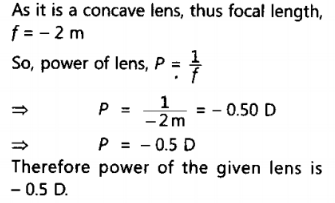
Question 1.
Which one of the following materials cannot be used to make a lens?
(a) Water (b) Glass
(c) Plastic (d) Clay
Answer:–
(d) Clay
Question 2.
The ¡mage formed by a concave mirror is observed to be virtual, erect and larger than the object. Where should be the position of the object?
(a) Between the principal focus and the centre of Curvature
(b) At the centre of curvature
(c) Beyond the centre of curvature
(d) Between the pole of the mirror and Its principal focus.
Answer–
(d) Between the pole of the mirror and its principal focus.
Question 3.
Where should an object b. placed In front of a convex lens to get a real
image of the size of the object?
(a) At the principal focus of the lens
(b) At twice the focal length
(c) At infinity
(d) Between the optical centre of the lens and its principal focus
Answer–
(b) At twice the focal length
Question 4.
A spherical mirror and a thin spherical lens have each a focal length of 15 cm. The mirror and the lens are likely to be:
(a) both concave
(b) both convex
(c) the mirror is concave, but the lens is convex
(d) the mirror is convex, but the lens is concave
Answer-
(a) Both concave.
Question 5.
No matter how far you stand from a mirror, your Image appears erect. The mirror is likely to be
(a) plane
(b) concave
(c) convex
(d) Either plane or convex
Answer–
(d) Either plane or convex.
Question 6.
Which of the following lenses would you prefer to use while reading small letters found ¡n a dictionary?
(a) A convex lens of focal length 50cm
(b) A concave lens of focal length 50cm
(c) A convex lens of focal length 5 cm
(d) A concave lens of focal length 5 cm.
Answer–
(c) A convex lens of focal length 5 cm.
Question 7.
We wish to obtain an erect image of an object, using a concave mirror of focal length 15 cm. what should be the range of distance of the object from the mirror? What is the nature of the image? Is the image larger or smaller than the object? Draw a ray diagram to show the image formation in this
case.
Answer-
We are given the focal length cf the concave mirror as f = -15cm.
For getting an erect image using a concave mirror, the object should be placed at a distance less than the focal length.
i.e. 15 cm from the pole. The image formed will be virtual, enlarged and erect.
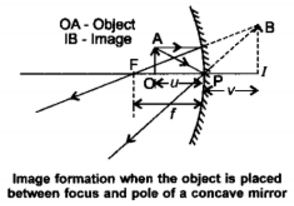
Question 8.
Name the type of mirror used in the following situations.
(a) Headlights of a car
(b) Side/rear-view mirror of a vehicle
(c) Solar furnace
Support your answer with reason.
Answer-
Concave mirror (a): This produces strong, parallel light beams.
(b) A convex mirror, which always provides an upright image and allows the driver to see a far wider area.
(c) A concave or parabolic mirror, which allows sunlight to be focused at the focal point and used to heat a solar boiler.
Question 9.
One half of a convex lens is covered with a black paper. Will this lens produce a complete image of the object? Verify your answer experimentally. Explain your observations.
Answer-
Yes, a complete image of the object will still form even if a black piece of paper covers half of the lens. To focus light from a far-off object onto a screen, use a convex lens. An image (sharp) forms at a distance equal to the focus length as predicted. To focus light from the same item onto the same screen, cover either the lower or top portion of the lens. In the second scenario, the image brightness will be lower, but you will be able to obtain a sharp image once more. Even if there are black strips covering half of the lens, the effect will still be seen.
Question 10.
An object 5cm in length is held 25cm away from a converging lens of focal length 10 cm. Draw a ray diagram and find the position, size and the nature of the image formed.
Answer-
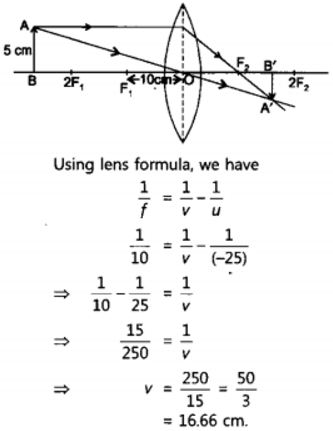
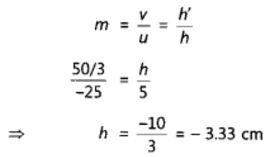
Therefore, the mage ¡s formed between F2 and 2F2 on the other side of the lens. It is real and inverted, and smaller in size than the object.

Question 12.
An object is placed at a distance of 10 cm from a convex mirror of focal length 15 cm. Find the position and nature of the ¡mage.
Answer-
f = +15 cm. u = -1o cm
For mirror, we have
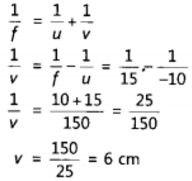
The image must be virtual and erect.
Question 13.
The magnification produced by a plane mirror is +1. What does this mean?
Answer-
This means that size of the image is equal to the size of the object.
Question 14.
An object 5.0 cm in length Is placedat a distanc, of 20 cm in front of a convex mirror of radius of curvature 30 cm. Find the position of the image nature and size.
Answer-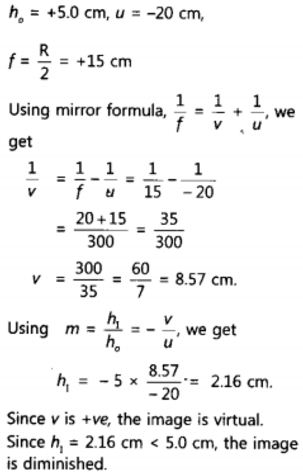
Question 15.
An object of size 7.0 cm is placed at 27 cm in front of a concave mirror of focal length 18 cm. At what distance from the mirror should a screen be placed, so that a sharp focused image can be obtained? Find the size and the nature of the image.
Answer–
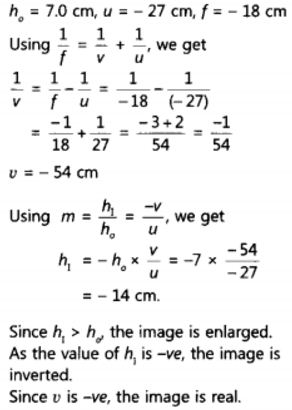
Question 16.
Find the focal length of a lens of power -2.0 D. What type of lens is this?
Answer–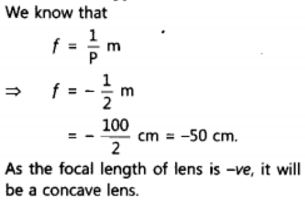
Question 17.
A doctor has prescribed a corrective lens of power +1.5 D. find the focal length of the lens. Is the prescribed lens diverging or converging?
Answer–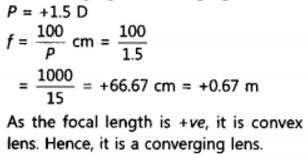

[…] 7 Control and CoordinationChapter 8 How Do Organisms ReproduceChapter 9 Heredity and EvolutionChapter 10 Light Reflection and Refraction Chapter 11 Human Eye and Colorful WorldChapter 12 ElectricityChapter 13 Magnetic Effects of […]
[…] NCERT Solutions for Class 10 Science Chapter 10 Light Reflection and Refraction […]